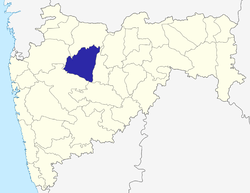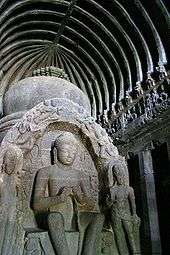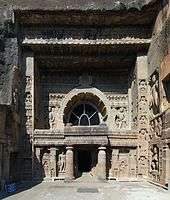Pitalkhora


The Pitalkhora Caves, in the Satamala range of the Western Ghats of Maharashtra, India, are an ancient Buddhist site consisting of 14 rock-cut cave monuments which date back to the third century BCE, making them one of the earliest examples of rock-cut architecture in India. Located about 40 kilometers from Ellora, the site is reached by a steep climb down a flight of concrete stairs, past a waterfall next to the caves.[1]
The caves are cut in a variety of basalt rock, but some of the caves have crumbled and are damaged. Out of the 14, four are chaityas (one housing votive stupas, one apsidal and single-cell) and the rest are viharas. All the caves belong to the Hinayana period, but the reasonably well preserved paintings are of the Mahayana period. The caves are in two groups, one of 10 caves and the second of four. It is believed that Pitalkhora can be identified with Ptolemy’s "Petrigala" as well as the "Pitangalya" of Mahamayuri, a Buddhist chronicle. The inscriptions date from c. 250 BCE to the 3rd and 4th centuries CE.[1]
The site shows statues of elephants, two soldiers of which one is intact, a damaged Gaja Lakshmi icon, and an ancient rainwater harvesting system.[1] These caves have been significant in helping establish the chronology of cave building in the Ajanta-Ellora region.[2]
Notes
- 1 2 3 Pitalkhora Caves at Archaeological Survey of India.
- ↑ James Burgess (1880). The Cave Temples of India. W.H. Allen & Company. pp. 516–519.
Further reading
- Brancaccio, Pia (2014). "Cave Architecture of India, in Encyclopaedia of the History of Science, Technology, and Medicine in Non-Western Cultures": 1–9. doi:10.1007/978-94-007-3934-5_9848-1.
External links
- Pitalkhora, archeological site, Encyclopedia Britannica
- Pitalkhora Caves at Archaeological Survey of India
- Pitalkhora Yaksha: Sankarin?, M. S. Mate (1966)
- Les temples rupestres de Pitalkhora en Inde, S Ueda (1978)
Coordinates: 20°18′49″N 74°59′39″E / 20.313473°N 74.994228°E



